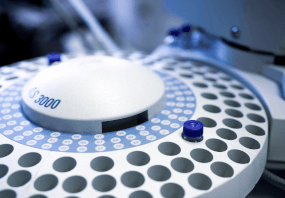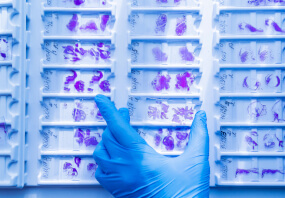General description
p53 was discovered in 1979 as a cellular protein associating with the transforming protein of SV40 tumor virus. Since then, many different biochemical functions have been attributed to the 53 kD phosphoprotein. Experimental evidence has suggested that p53 acts as a negative regulator of cell growth in normal cells (Finlay, 1989). Thus, the inactivation or mutation of p53 may be an essential step in the development of malignancy (Lane and Benchmol, 1990). Wild-type p53 levels in normal cells and tissues were found to be very low. Mutant p53 polypeptide, however, is often found to be present at high concentrations in mammalian tumors and tumor cell lines. For example, in an immuno-histochemistry study 40% of human breast cancer showed elevated levels of mutant p53 in the cell nucleus. Mutations of the p53 protein have some characteristic features:
a) Most of them are missense point mutations giving rise to an altered protein function.
b) Many -but not all- mutant p53 proteins exhibit a common mutant structure, which can be recognized by monoclonal antibodies specific for p53 in the mutant conformation.
Specificity
This antibody recognizes p53 acetylated at Lys320.
Immunogen
Epitope: Acetyl Lys 320
KLH-conjugated linear peptide corresponding to p53 at Lys320.
Application
Research Category
Epigenetics & Nuclear Function
Research Sub Category
Transcription Factors
Use Anti-acetyl-p53 (Lys320) Antibody (Rabbit Polyclonal Antibody) validated in WB to detect acetyl-p53 (Lys320) also known as Antigen NY-CO-13, Phosphoprotein p53, Tumor suppressor p53, p53 antigen.
Western Blot Analysis: 5 µg/mL antibody detected p53 on 10 µg of A549 cells treated with UV & TSA lysate.
Western Blot (SNAP ID) Analysis: 5 µg/mL antibody detected p53 on 10 µg of recombinant proteins.
Quality
Evaluated by Western Blotting using A549 cells treated with UV & TSA.
Western Blotting Analysis: 5 µg/mL of a representative lot of this antibody detected p53 on 10 µg of A549 cells treated with UV & TSA lysate.
Target description
~ 53 kDa observed. Western Blot of A549 cells treated with UV & TSA show bands at ~48 kDa and ~14 kDa which are likely breakdown products of p53 reported for UV treated cells. (Sadji-Ouatas, 2002)
Linkage
Replaces: 06-915
Physical form
Affinity purified
Purified rabbit polyclonal in buffer containing 0.1 M Tris-Glycine (pH 7.4), 150 mM NaCl with 0.05% sodium azide.
Storage and Stability
Stable for 1 year at 2-8°C from date of receipt.
Analysis Note
Control
Recombinant proteins
Other Notes
Concentration: Please refer to the Certificate of Analysis for the lot-specific concentration.
Disclaimer
Unless otherwise stated in our catalog or other company documentation accompanying the product(s), our products are intended for research use only and are not to be used for any other purpose, which includes but is not limited to, unauthorized commercial uses, in vitro diagnostic uses, ex vivo or in vivo therapeutic uses or any type of consumption or application to humans or animals.
Shipping Information:
Dry Ice Surcharge & Ice Pack Shipments: $40
More Information: https://cenmed.com/shipping-returns
- UPC:
- 51111855
- Condition:
- New
- Availability:
- 3-5 Days
- Weight:
- 1.00 Ounces
- HazmatClass:
- No
- MPN:
- 06-1283
- Temperature Control Device:
- Yes












